Associations between Job Insecurity and Employee Well-being Study
VerifiedAdded on 2024/07/24
|10
|2755
|162
Report
AI Summary
This report investigates the associations between quantitative and qualitative job insecurity and employee well-being, utilizing data collected from 69,000 employees across 63 Belgian banks. A stratified random sampling method was employed, selecting approximately 15,000 employees (21% of the population) for the study. The research design involves primary analysis of data obtained through a questionnaire-based survey. The report discusses the sample size, sampling method, measures of variables (reliability and validity), collection of data on social demographics (gender, age, education level), and the research design's merits and demerits. Cronbach's alpha is used to measure the reliability of the data, with values of 0.87 and 0.89 for qualitative and quantitative job insecurity, respectively, indicating reliable data. The study aims to understand how different forms of job insecurity relate to employee well-being, considering demographic factors to provide a comprehensive analysis.
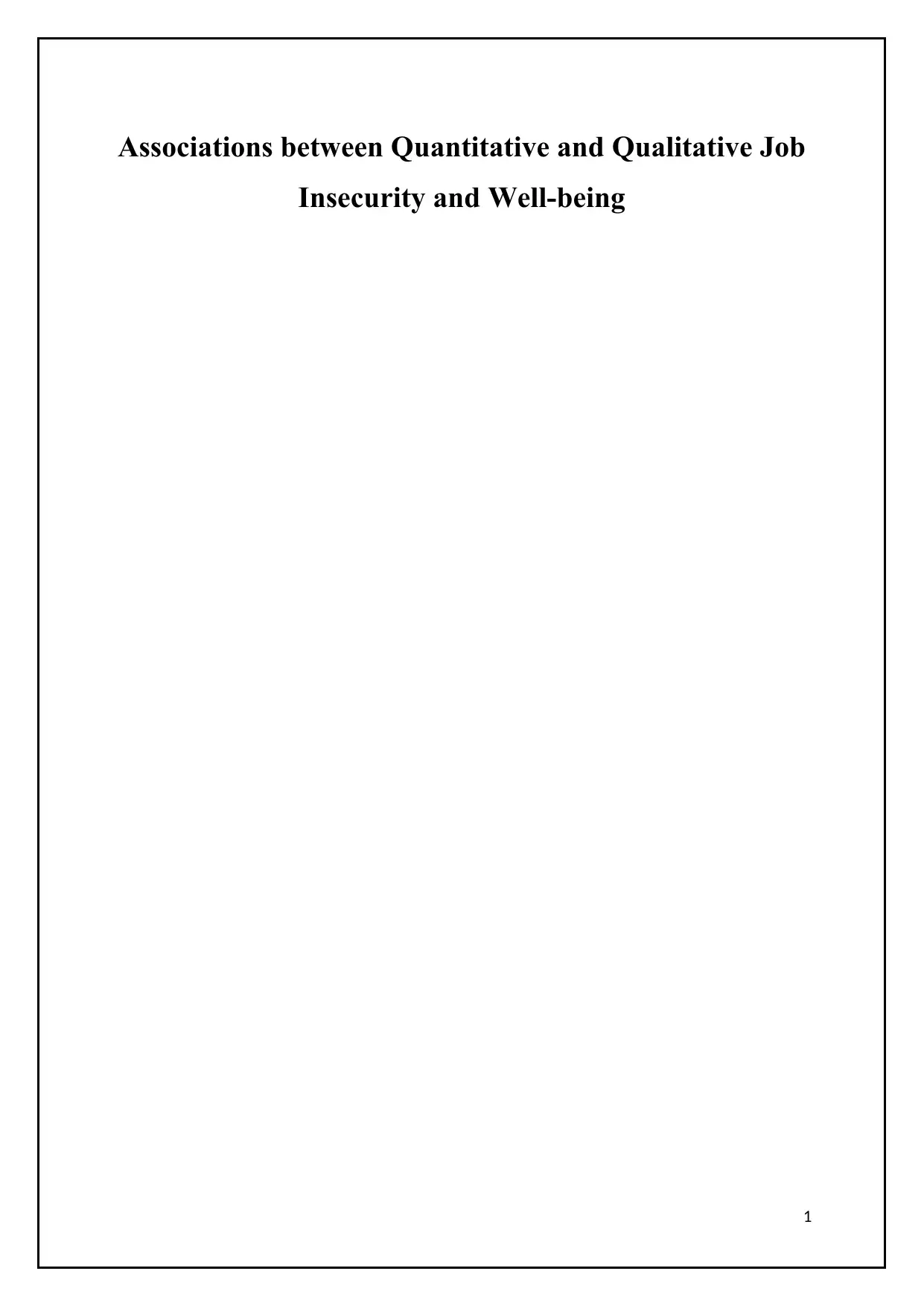
Associations between Quantitative and Qualitative Job
Insecurity and Well-being
1
Insecurity and Well-being
1
Paraphrase This Document
Need a fresh take? Get an instant paraphrase of this document with our AI Paraphraser
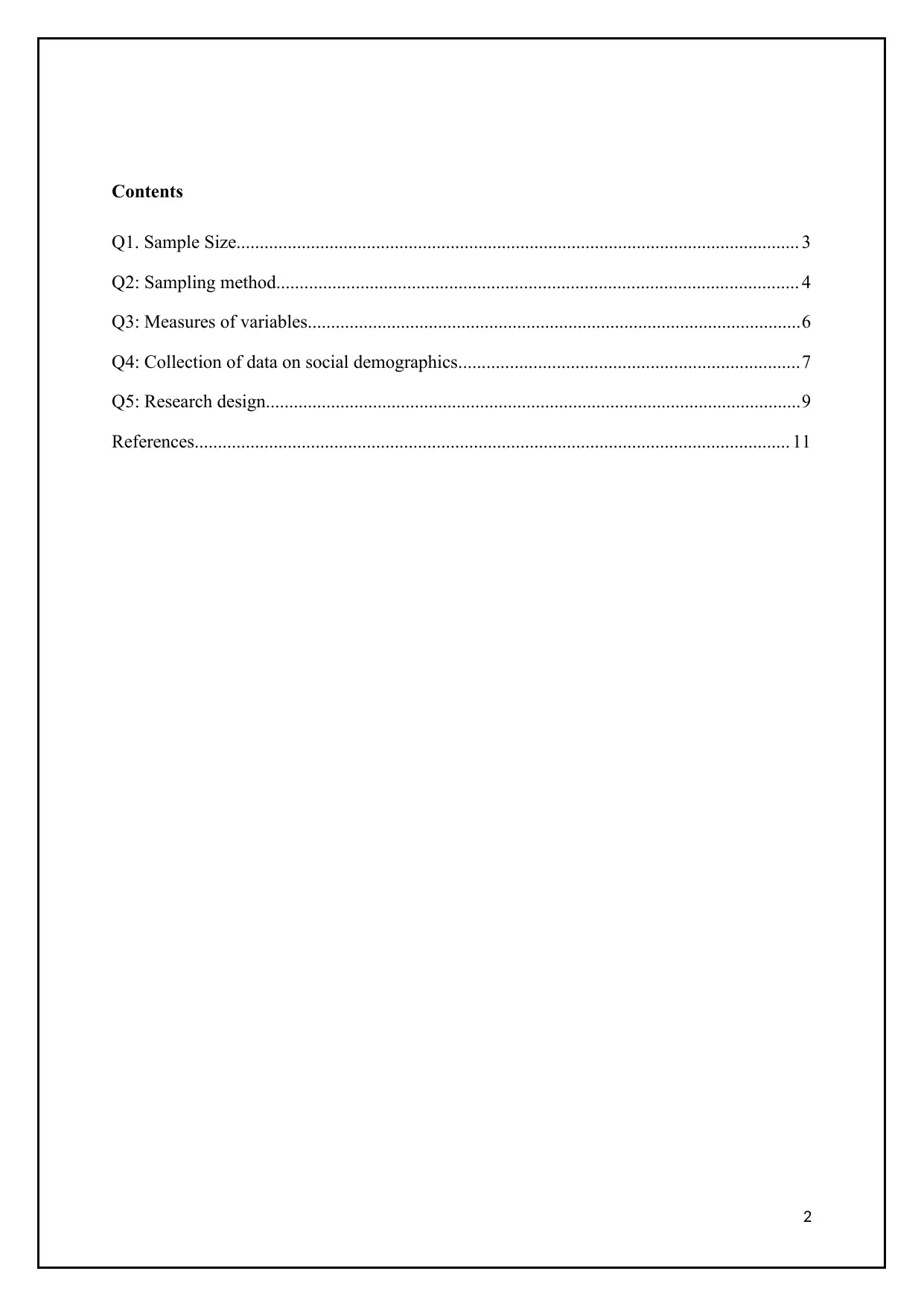
Contents
Q1. Sample Size......................................................................................................................... 3
Q2: Sampling method................................................................................................................ 4
Q3: Measures of variables..........................................................................................................6
Q4: Collection of data on social demographics.........................................................................7
Q5: Research design...................................................................................................................9
References................................................................................................................................ 11
2
Q1. Sample Size......................................................................................................................... 3
Q2: Sampling method................................................................................................................ 4
Q3: Measures of variables..........................................................................................................6
Q4: Collection of data on social demographics.........................................................................7
Q5: Research design...................................................................................................................9
References................................................................................................................................ 11
2
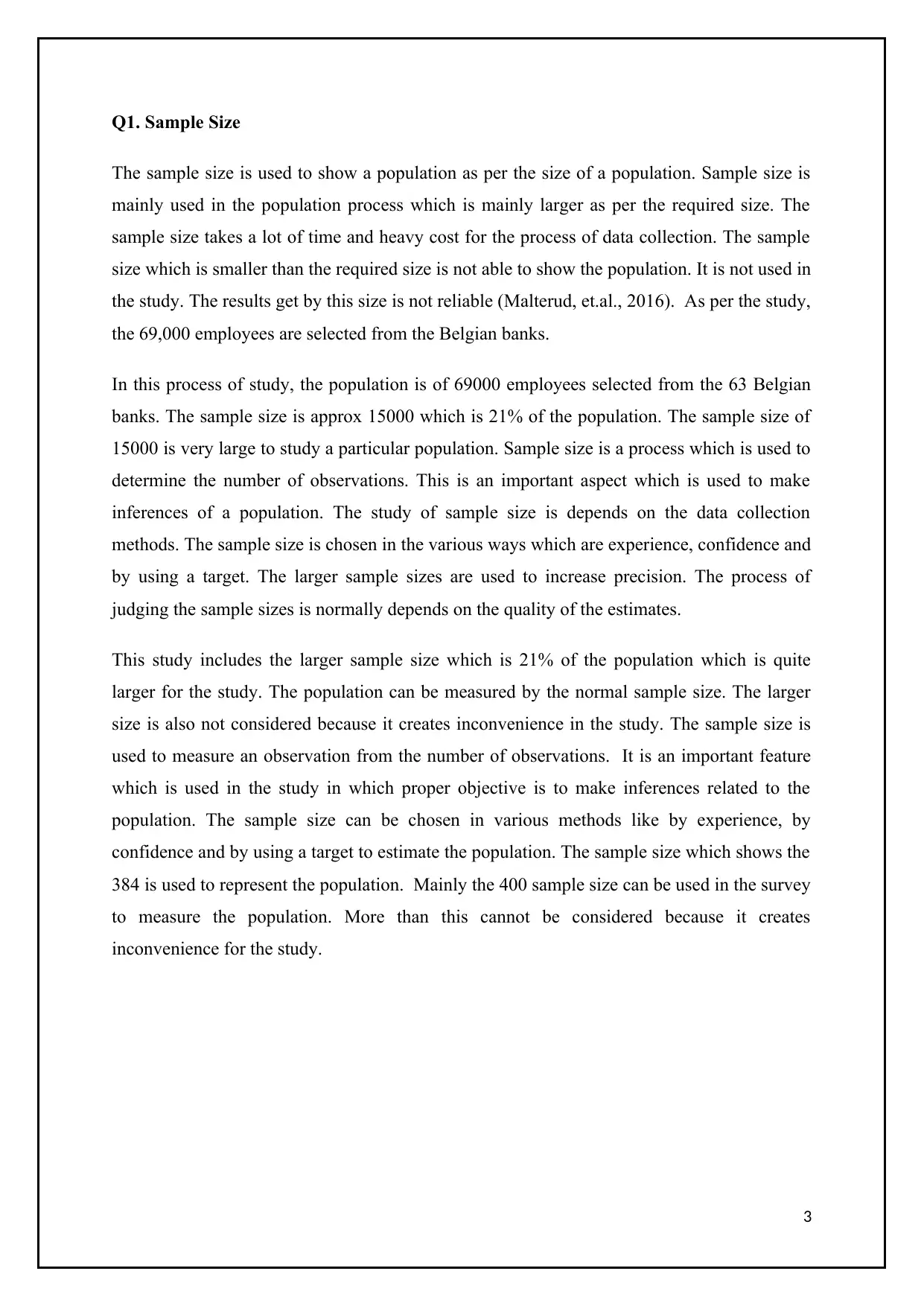
Q1. Sample Size
The sample size is used to show a population as per the size of a population. Sample size is
mainly used in the population process which is mainly larger as per the required size. The
sample size takes a lot of time and heavy cost for the process of data collection. The sample
size which is smaller than the required size is not able to show the population. It is not used in
the study. The results get by this size is not reliable (Malterud, et.al., 2016). As per the study,
the 69,000 employees are selected from the Belgian banks.
In this process of study, the population is of 69000 employees selected from the 63 Belgian
banks. The sample size is approx 15000 which is 21% of the population. The sample size of
15000 is very large to study a particular population. Sample size is a process which is used to
determine the number of observations. This is an important aspect which is used to make
inferences of a population. The study of sample size is depends on the data collection
methods. The sample size is chosen in the various ways which are experience, confidence and
by using a target. The larger sample sizes are used to increase precision. The process of
judging the sample sizes is normally depends on the quality of the estimates.
This study includes the larger sample size which is 21% of the population which is quite
larger for the study. The population can be measured by the normal sample size. The larger
size is also not considered because it creates inconvenience in the study. The sample size is
used to measure an observation from the number of observations. It is an important feature
which is used in the study in which proper objective is to make inferences related to the
population. The sample size can be chosen in various methods like by experience, by
confidence and by using a target to estimate the population. The sample size which shows the
384 is used to represent the population. Mainly the 400 sample size can be used in the survey
to measure the population. More than this cannot be considered because it creates
inconvenience for the study.
3
The sample size is used to show a population as per the size of a population. Sample size is
mainly used in the population process which is mainly larger as per the required size. The
sample size takes a lot of time and heavy cost for the process of data collection. The sample
size which is smaller than the required size is not able to show the population. It is not used in
the study. The results get by this size is not reliable (Malterud, et.al., 2016). As per the study,
the 69,000 employees are selected from the Belgian banks.
In this process of study, the population is of 69000 employees selected from the 63 Belgian
banks. The sample size is approx 15000 which is 21% of the population. The sample size of
15000 is very large to study a particular population. Sample size is a process which is used to
determine the number of observations. This is an important aspect which is used to make
inferences of a population. The study of sample size is depends on the data collection
methods. The sample size is chosen in the various ways which are experience, confidence and
by using a target. The larger sample sizes are used to increase precision. The process of
judging the sample sizes is normally depends on the quality of the estimates.
This study includes the larger sample size which is 21% of the population which is quite
larger for the study. The population can be measured by the normal sample size. The larger
size is also not considered because it creates inconvenience in the study. The sample size is
used to measure an observation from the number of observations. It is an important feature
which is used in the study in which proper objective is to make inferences related to the
population. The sample size can be chosen in various methods like by experience, by
confidence and by using a target to estimate the population. The sample size which shows the
384 is used to represent the population. Mainly the 400 sample size can be used in the survey
to measure the population. More than this cannot be considered because it creates
inconvenience for the study.
3
⊘ This is a preview!⊘
Do you want full access?
Subscribe today to unlock all pages.

Trusted by 1+ million students worldwide
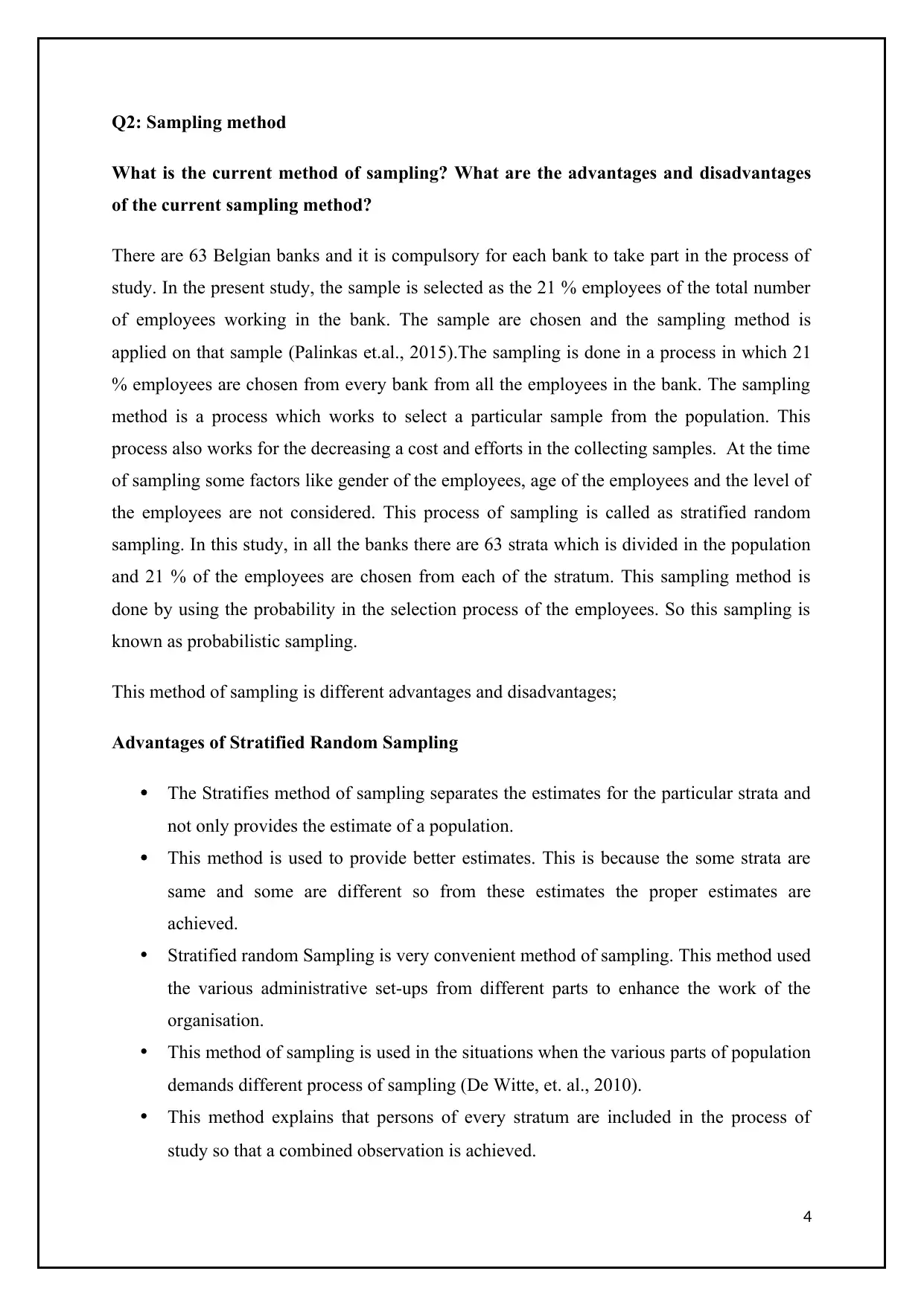
Q2: Sampling method
What is the current method of sampling? What are the advantages and disadvantages
of the current sampling method?
There are 63 Belgian banks and it is compulsory for each bank to take part in the process of
study. In the present study, the sample is selected as the 21 % employees of the total number
of employees working in the bank. The sample are chosen and the sampling method is
applied on that sample (Palinkas et.al., 2015).The sampling is done in a process in which 21
% employees are chosen from every bank from all the employees in the bank. The sampling
method is a process which works to select a particular sample from the population. This
process also works for the decreasing a cost and efforts in the collecting samples. At the time
of sampling some factors like gender of the employees, age of the employees and the level of
the employees are not considered. This process of sampling is called as stratified random
sampling. In this study, in all the banks there are 63 strata which is divided in the population
and 21 % of the employees are chosen from each of the stratum. This sampling method is
done by using the probability in the selection process of the employees. So this sampling is
known as probabilistic sampling.
This method of sampling is different advantages and disadvantages;
Advantages of Stratified Random Sampling
The Stratifies method of sampling separates the estimates for the particular strata and
not only provides the estimate of a population.
This method is used to provide better estimates. This is because the some strata are
same and some are different so from these estimates the proper estimates are
achieved.
Stratified random Sampling is very convenient method of sampling. This method used
the various administrative set-ups from different parts to enhance the work of the
organisation.
This method of sampling is used in the situations when the various parts of population
demands different process of sampling (De Witte, et. al., 2010).
This method explains that persons of every stratum are included in the process of
study so that a combined observation is achieved.
4
What is the current method of sampling? What are the advantages and disadvantages
of the current sampling method?
There are 63 Belgian banks and it is compulsory for each bank to take part in the process of
study. In the present study, the sample is selected as the 21 % employees of the total number
of employees working in the bank. The sample are chosen and the sampling method is
applied on that sample (Palinkas et.al., 2015).The sampling is done in a process in which 21
% employees are chosen from every bank from all the employees in the bank. The sampling
method is a process which works to select a particular sample from the population. This
process also works for the decreasing a cost and efforts in the collecting samples. At the time
of sampling some factors like gender of the employees, age of the employees and the level of
the employees are not considered. This process of sampling is called as stratified random
sampling. In this study, in all the banks there are 63 strata which is divided in the population
and 21 % of the employees are chosen from each of the stratum. This sampling method is
done by using the probability in the selection process of the employees. So this sampling is
known as probabilistic sampling.
This method of sampling is different advantages and disadvantages;
Advantages of Stratified Random Sampling
The Stratifies method of sampling separates the estimates for the particular strata and
not only provides the estimate of a population.
This method is used to provide better estimates. This is because the some strata are
same and some are different so from these estimates the proper estimates are
achieved.
Stratified random Sampling is very convenient method of sampling. This method used
the various administrative set-ups from different parts to enhance the work of the
organisation.
This method of sampling is used in the situations when the various parts of population
demands different process of sampling (De Witte, et. al., 2010).
This method explains that persons of every stratum are included in the process of
study so that a combined observation is achieved.
4
Paraphrase This Document
Need a fresh take? Get an instant paraphrase of this document with our AI Paraphraser
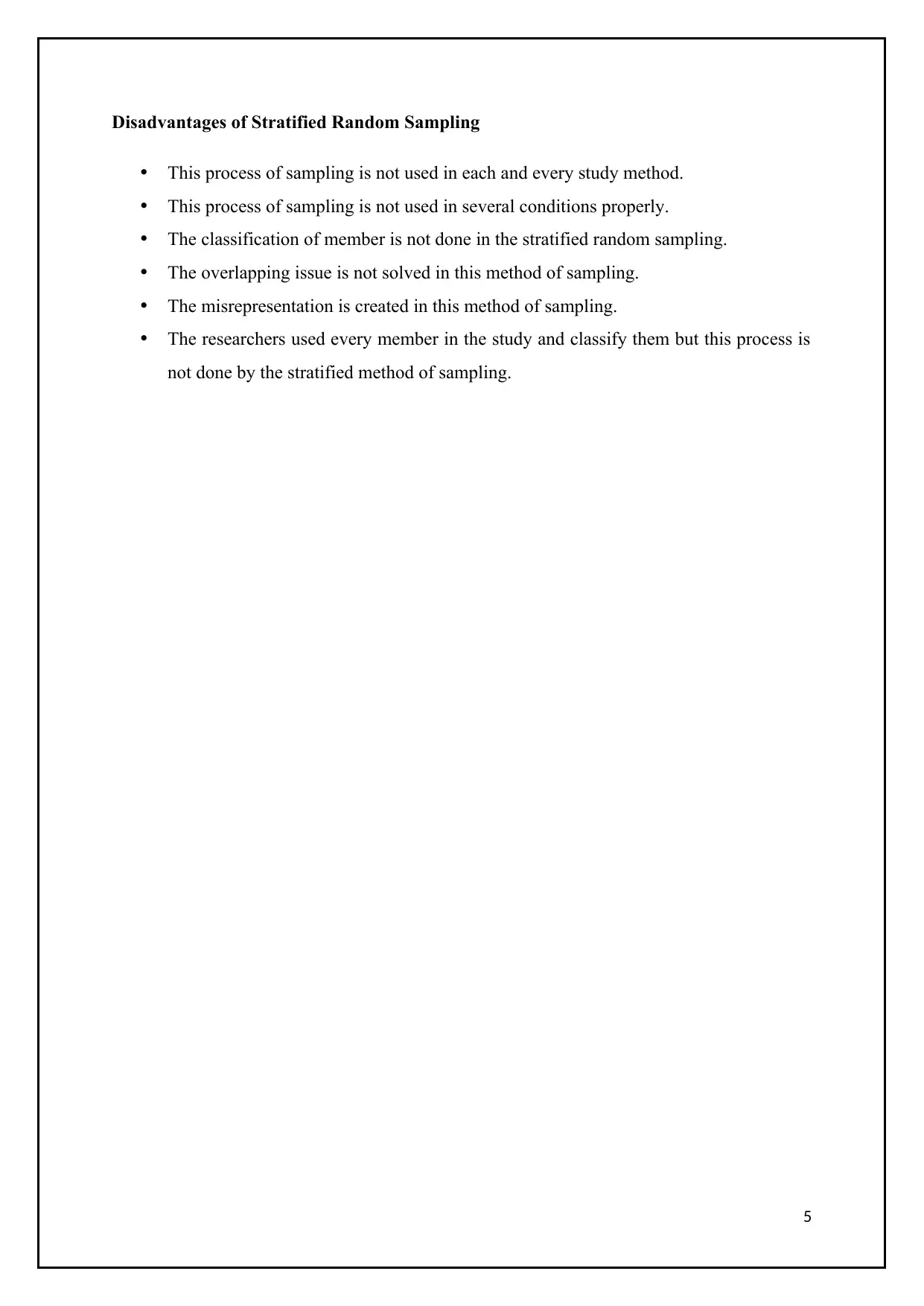
Disadvantages of Stratified Random Sampling
This process of sampling is not used in each and every study method.
This process of sampling is not used in several conditions properly.
The classification of member is not done in the stratified random sampling.
The overlapping issue is not solved in this method of sampling.
The misrepresentation is created in this method of sampling.
The researchers used every member in the study and classify them but this process is
not done by the stratified method of sampling.
5
This process of sampling is not used in each and every study method.
This process of sampling is not used in several conditions properly.
The classification of member is not done in the stratified random sampling.
The overlapping issue is not solved in this method of sampling.
The misrepresentation is created in this method of sampling.
The researchers used every member in the study and classify them but this process is
not done by the stratified method of sampling.
5
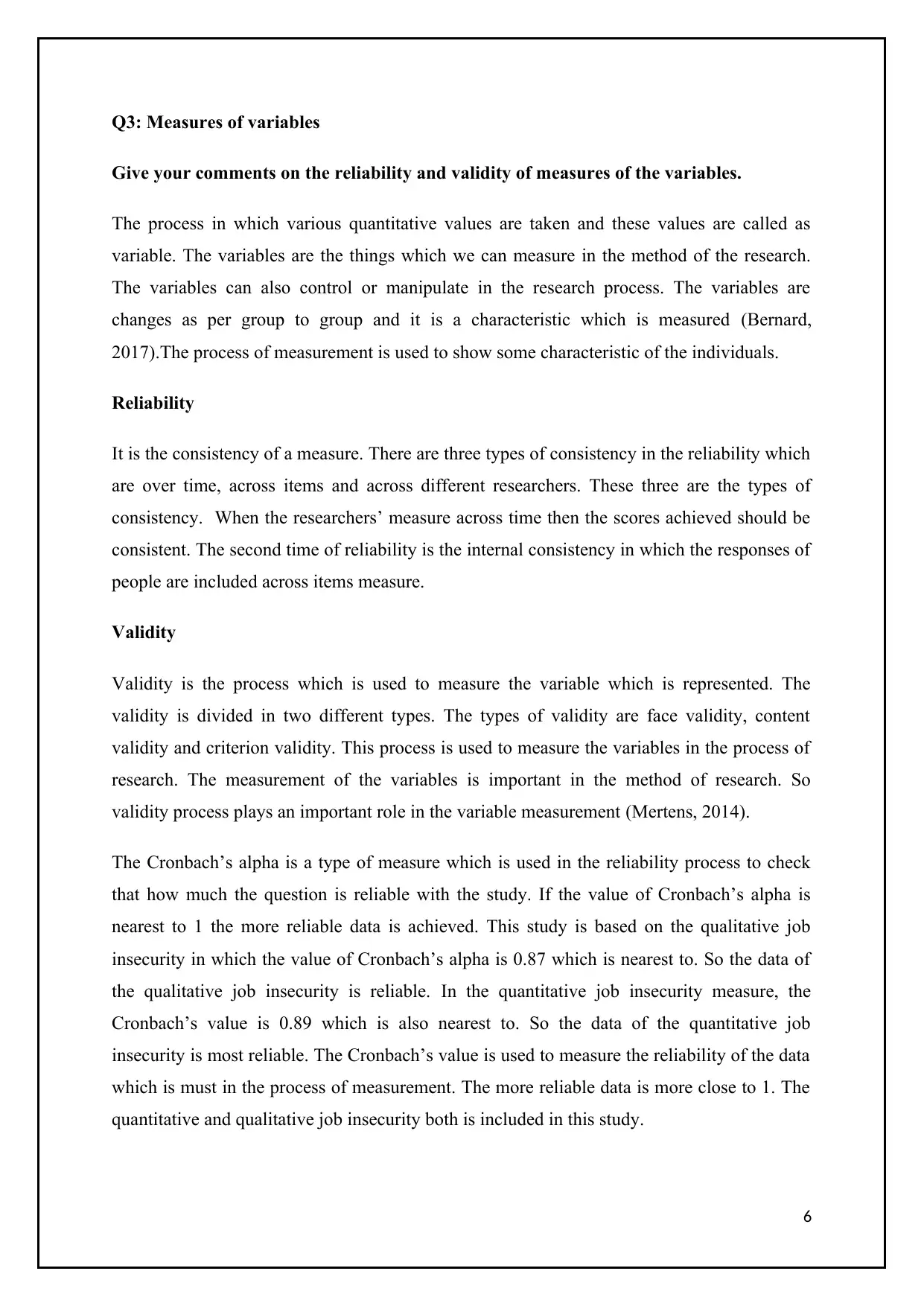
Q3: Measures of variables
Give your comments on the reliability and validity of measures of the variables.
The process in which various quantitative values are taken and these values are called as
variable. The variables are the things which we can measure in the method of the research.
The variables can also control or manipulate in the research process. The variables are
changes as per group to group and it is a characteristic which is measured (Bernard,
2017).The process of measurement is used to show some characteristic of the individuals.
Reliability
It is the consistency of a measure. There are three types of consistency in the reliability which
are over time, across items and across different researchers. These three are the types of
consistency. When the researchers’ measure across time then the scores achieved should be
consistent. The second time of reliability is the internal consistency in which the responses of
people are included across items measure.
Validity
Validity is the process which is used to measure the variable which is represented. The
validity is divided in two different types. The types of validity are face validity, content
validity and criterion validity. This process is used to measure the variables in the process of
research. The measurement of the variables is important in the method of research. So
validity process plays an important role in the variable measurement (Mertens, 2014).
The Cronbach’s alpha is a type of measure which is used in the reliability process to check
that how much the question is reliable with the study. If the value of Cronbach’s alpha is
nearest to 1 the more reliable data is achieved. This study is based on the qualitative job
insecurity in which the value of Cronbach’s alpha is 0.87 which is nearest to. So the data of
the qualitative job insecurity is reliable. In the quantitative job insecurity measure, the
Cronbach’s value is 0.89 which is also nearest to. So the data of the quantitative job
insecurity is most reliable. The Cronbach’s value is used to measure the reliability of the data
which is must in the process of measurement. The more reliable data is more close to 1. The
quantitative and qualitative job insecurity both is included in this study.
6
Give your comments on the reliability and validity of measures of the variables.
The process in which various quantitative values are taken and these values are called as
variable. The variables are the things which we can measure in the method of the research.
The variables can also control or manipulate in the research process. The variables are
changes as per group to group and it is a characteristic which is measured (Bernard,
2017).The process of measurement is used to show some characteristic of the individuals.
Reliability
It is the consistency of a measure. There are three types of consistency in the reliability which
are over time, across items and across different researchers. These three are the types of
consistency. When the researchers’ measure across time then the scores achieved should be
consistent. The second time of reliability is the internal consistency in which the responses of
people are included across items measure.
Validity
Validity is the process which is used to measure the variable which is represented. The
validity is divided in two different types. The types of validity are face validity, content
validity and criterion validity. This process is used to measure the variables in the process of
research. The measurement of the variables is important in the method of research. So
validity process plays an important role in the variable measurement (Mertens, 2014).
The Cronbach’s alpha is a type of measure which is used in the reliability process to check
that how much the question is reliable with the study. If the value of Cronbach’s alpha is
nearest to 1 the more reliable data is achieved. This study is based on the qualitative job
insecurity in which the value of Cronbach’s alpha is 0.87 which is nearest to. So the data of
the qualitative job insecurity is reliable. In the quantitative job insecurity measure, the
Cronbach’s value is 0.89 which is also nearest to. So the data of the quantitative job
insecurity is most reliable. The Cronbach’s value is used to measure the reliability of the data
which is must in the process of measurement. The more reliable data is more close to 1. The
quantitative and qualitative job insecurity both is included in this study.
6
⊘ This is a preview!⊘
Do you want full access?
Subscribe today to unlock all pages.

Trusted by 1+ million students worldwide
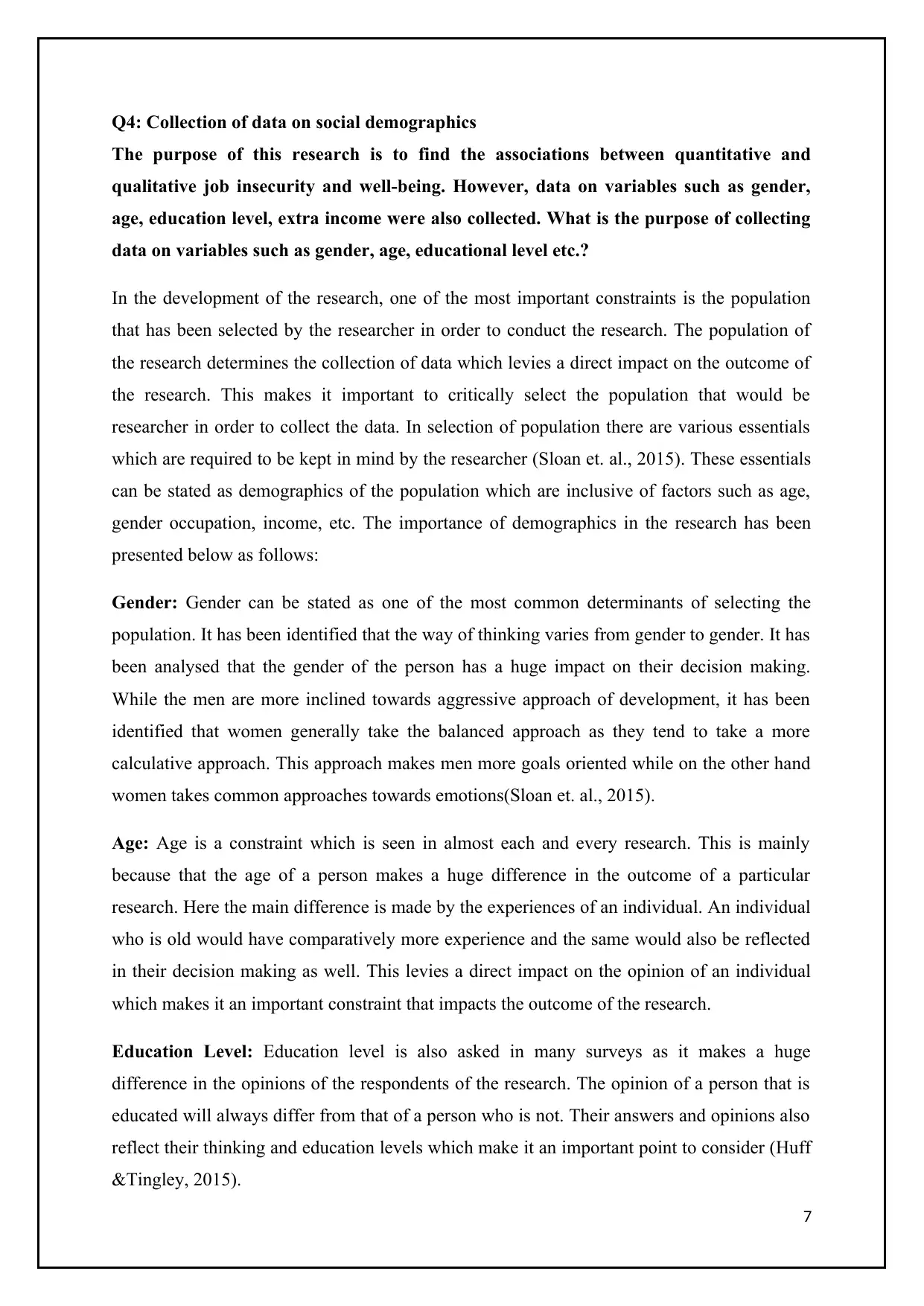
Q4: Collection of data on social demographics
The purpose of this research is to find the associations between quantitative and
qualitative job insecurity and well-being. However, data on variables such as gender,
age, education level, extra income were also collected. What is the purpose of collecting
data on variables such as gender, age, educational level etc.?
In the development of the research, one of the most important constraints is the population
that has been selected by the researcher in order to conduct the research. The population of
the research determines the collection of data which levies a direct impact on the outcome of
the research. This makes it important to critically select the population that would be
researcher in order to collect the data. In selection of population there are various essentials
which are required to be kept in mind by the researcher (Sloan et. al., 2015). These essentials
can be stated as demographics of the population which are inclusive of factors such as age,
gender occupation, income, etc. The importance of demographics in the research has been
presented below as follows:
Gender: Gender can be stated as one of the most common determinants of selecting the
population. It has been identified that the way of thinking varies from gender to gender. It has
been analysed that the gender of the person has a huge impact on their decision making.
While the men are more inclined towards aggressive approach of development, it has been
identified that women generally take the balanced approach as they tend to take a more
calculative approach. This approach makes men more goals oriented while on the other hand
women takes common approaches towards emotions(Sloan et. al., 2015).
Age: Age is a constraint which is seen in almost each and every research. This is mainly
because that the age of a person makes a huge difference in the outcome of a particular
research. Here the main difference is made by the experiences of an individual. An individual
who is old would have comparatively more experience and the same would also be reflected
in their decision making as well. This levies a direct impact on the opinion of an individual
which makes it an important constraint that impacts the outcome of the research.
Education Level: Education level is also asked in many surveys as it makes a huge
difference in the opinions of the respondents of the research. The opinion of a person that is
educated will always differ from that of a person who is not. Their answers and opinions also
reflect their thinking and education levels which make it an important point to consider (Huff
&Tingley, 2015).
7
The purpose of this research is to find the associations between quantitative and
qualitative job insecurity and well-being. However, data on variables such as gender,
age, education level, extra income were also collected. What is the purpose of collecting
data on variables such as gender, age, educational level etc.?
In the development of the research, one of the most important constraints is the population
that has been selected by the researcher in order to conduct the research. The population of
the research determines the collection of data which levies a direct impact on the outcome of
the research. This makes it important to critically select the population that would be
researcher in order to collect the data. In selection of population there are various essentials
which are required to be kept in mind by the researcher (Sloan et. al., 2015). These essentials
can be stated as demographics of the population which are inclusive of factors such as age,
gender occupation, income, etc. The importance of demographics in the research has been
presented below as follows:
Gender: Gender can be stated as one of the most common determinants of selecting the
population. It has been identified that the way of thinking varies from gender to gender. It has
been analysed that the gender of the person has a huge impact on their decision making.
While the men are more inclined towards aggressive approach of development, it has been
identified that women generally take the balanced approach as they tend to take a more
calculative approach. This approach makes men more goals oriented while on the other hand
women takes common approaches towards emotions(Sloan et. al., 2015).
Age: Age is a constraint which is seen in almost each and every research. This is mainly
because that the age of a person makes a huge difference in the outcome of a particular
research. Here the main difference is made by the experiences of an individual. An individual
who is old would have comparatively more experience and the same would also be reflected
in their decision making as well. This levies a direct impact on the opinion of an individual
which makes it an important constraint that impacts the outcome of the research.
Education Level: Education level is also asked in many surveys as it makes a huge
difference in the opinions of the respondents of the research. The opinion of a person that is
educated will always differ from that of a person who is not. Their answers and opinions also
reflect their thinking and education levels which make it an important point to consider (Huff
&Tingley, 2015).
7
Paraphrase This Document
Need a fresh take? Get an instant paraphrase of this document with our AI Paraphraser
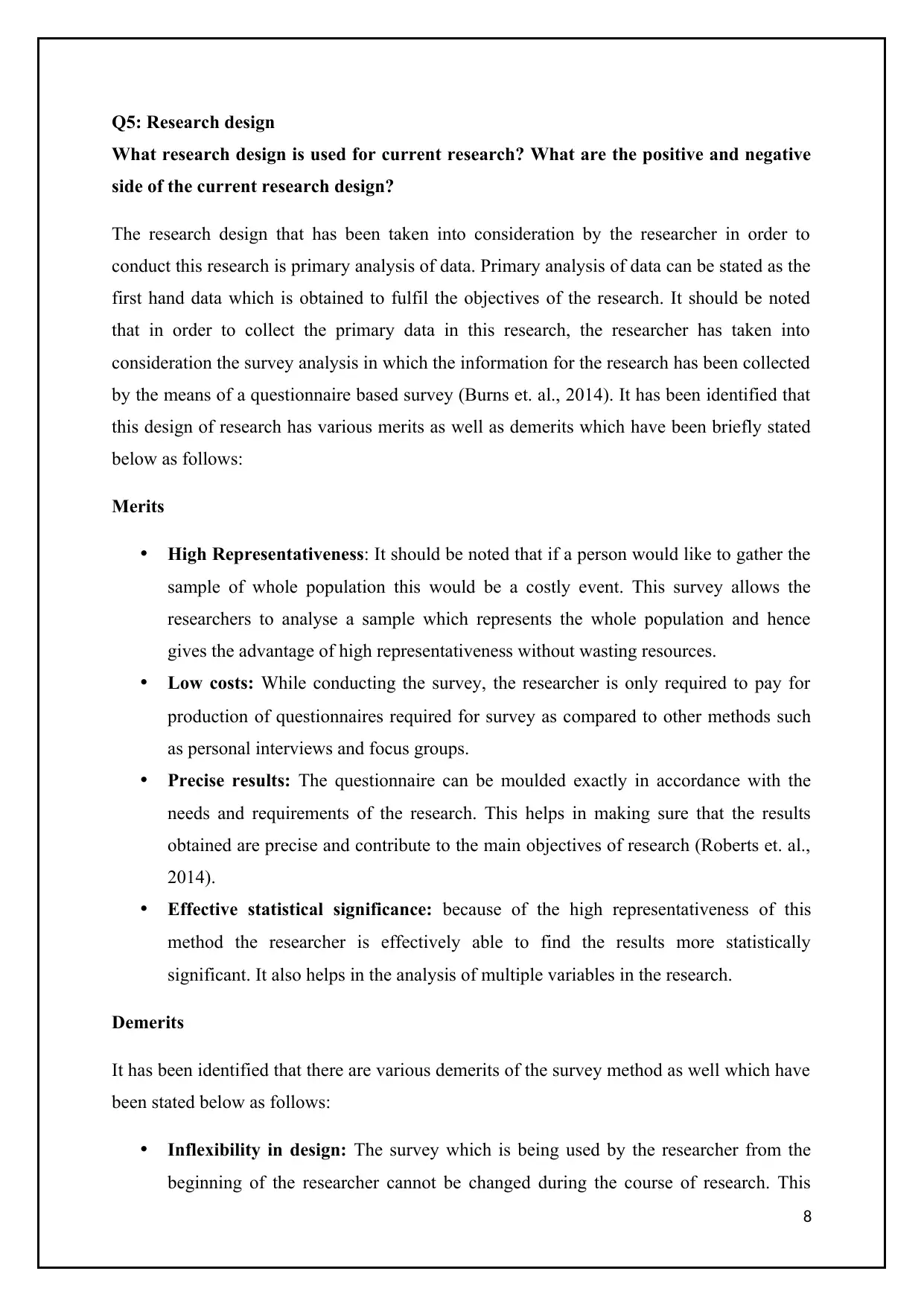
Q5: Research design
What research design is used for current research? What are the positive and negative
side of the current research design?
The research design that has been taken into consideration by the researcher in order to
conduct this research is primary analysis of data. Primary analysis of data can be stated as the
first hand data which is obtained to fulfil the objectives of the research. It should be noted
that in order to collect the primary data in this research, the researcher has taken into
consideration the survey analysis in which the information for the research has been collected
by the means of a questionnaire based survey (Burns et. al., 2014). It has been identified that
this design of research has various merits as well as demerits which have been briefly stated
below as follows:
Merits
High Representativeness: It should be noted that if a person would like to gather the
sample of whole population this would be a costly event. This survey allows the
researchers to analyse a sample which represents the whole population and hence
gives the advantage of high representativeness without wasting resources.
Low costs: While conducting the survey, the researcher is only required to pay for
production of questionnaires required for survey as compared to other methods such
as personal interviews and focus groups.
Precise results: The questionnaire can be moulded exactly in accordance with the
needs and requirements of the research. This helps in making sure that the results
obtained are precise and contribute to the main objectives of research (Roberts et. al.,
2014).
Effective statistical significance: because of the high representativeness of this
method the researcher is effectively able to find the results more statistically
significant. It also helps in the analysis of multiple variables in the research.
Demerits
It has been identified that there are various demerits of the survey method as well which have
been stated below as follows:
Inflexibility in design: The survey which is being used by the researcher from the
beginning of the researcher cannot be changed during the course of research. This
8
What research design is used for current research? What are the positive and negative
side of the current research design?
The research design that has been taken into consideration by the researcher in order to
conduct this research is primary analysis of data. Primary analysis of data can be stated as the
first hand data which is obtained to fulfil the objectives of the research. It should be noted
that in order to collect the primary data in this research, the researcher has taken into
consideration the survey analysis in which the information for the research has been collected
by the means of a questionnaire based survey (Burns et. al., 2014). It has been identified that
this design of research has various merits as well as demerits which have been briefly stated
below as follows:
Merits
High Representativeness: It should be noted that if a person would like to gather the
sample of whole population this would be a costly event. This survey allows the
researchers to analyse a sample which represents the whole population and hence
gives the advantage of high representativeness without wasting resources.
Low costs: While conducting the survey, the researcher is only required to pay for
production of questionnaires required for survey as compared to other methods such
as personal interviews and focus groups.
Precise results: The questionnaire can be moulded exactly in accordance with the
needs and requirements of the research. This helps in making sure that the results
obtained are precise and contribute to the main objectives of research (Roberts et. al.,
2014).
Effective statistical significance: because of the high representativeness of this
method the researcher is effectively able to find the results more statistically
significant. It also helps in the analysis of multiple variables in the research.
Demerits
It has been identified that there are various demerits of the survey method as well which have
been stated below as follows:
Inflexibility in design: The survey which is being used by the researcher from the
beginning of the researcher cannot be changed during the course of research. This
8
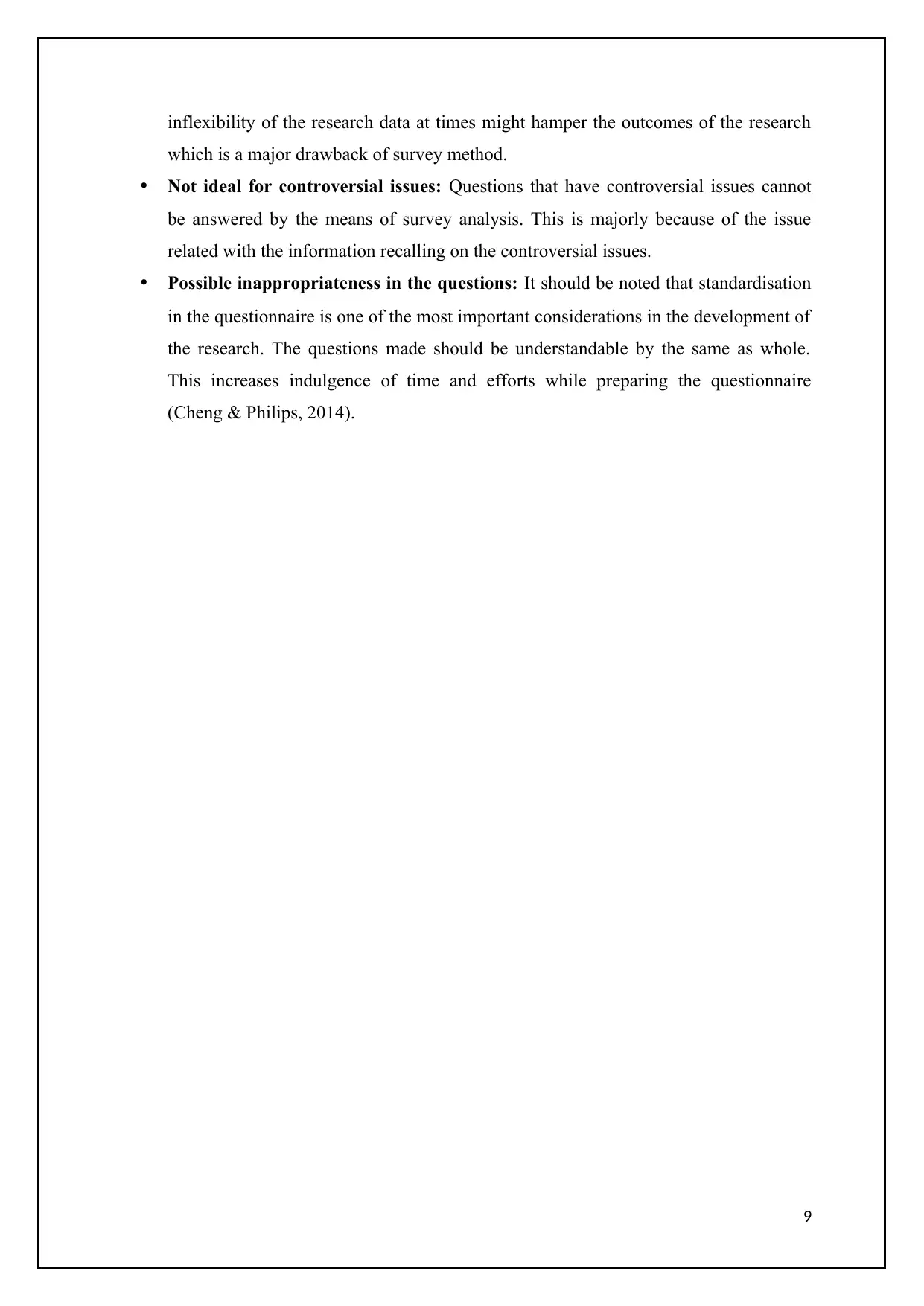
inflexibility of the research data at times might hamper the outcomes of the research
which is a major drawback of survey method.
Not ideal for controversial issues: Questions that have controversial issues cannot
be answered by the means of survey analysis. This is majorly because of the issue
related with the information recalling on the controversial issues.
Possible inappropriateness in the questions: It should be noted that standardisation
in the questionnaire is one of the most important considerations in the development of
the research. The questions made should be understandable by the same as whole.
This increases indulgence of time and efforts while preparing the questionnaire
(Cheng & Philips, 2014).
9
which is a major drawback of survey method.
Not ideal for controversial issues: Questions that have controversial issues cannot
be answered by the means of survey analysis. This is majorly because of the issue
related with the information recalling on the controversial issues.
Possible inappropriateness in the questions: It should be noted that standardisation
in the questionnaire is one of the most important considerations in the development of
the research. The questions made should be understandable by the same as whole.
This increases indulgence of time and efforts while preparing the questionnaire
(Cheng & Philips, 2014).
9
⊘ This is a preview!⊘
Do you want full access?
Subscribe today to unlock all pages.

Trusted by 1+ million students worldwide
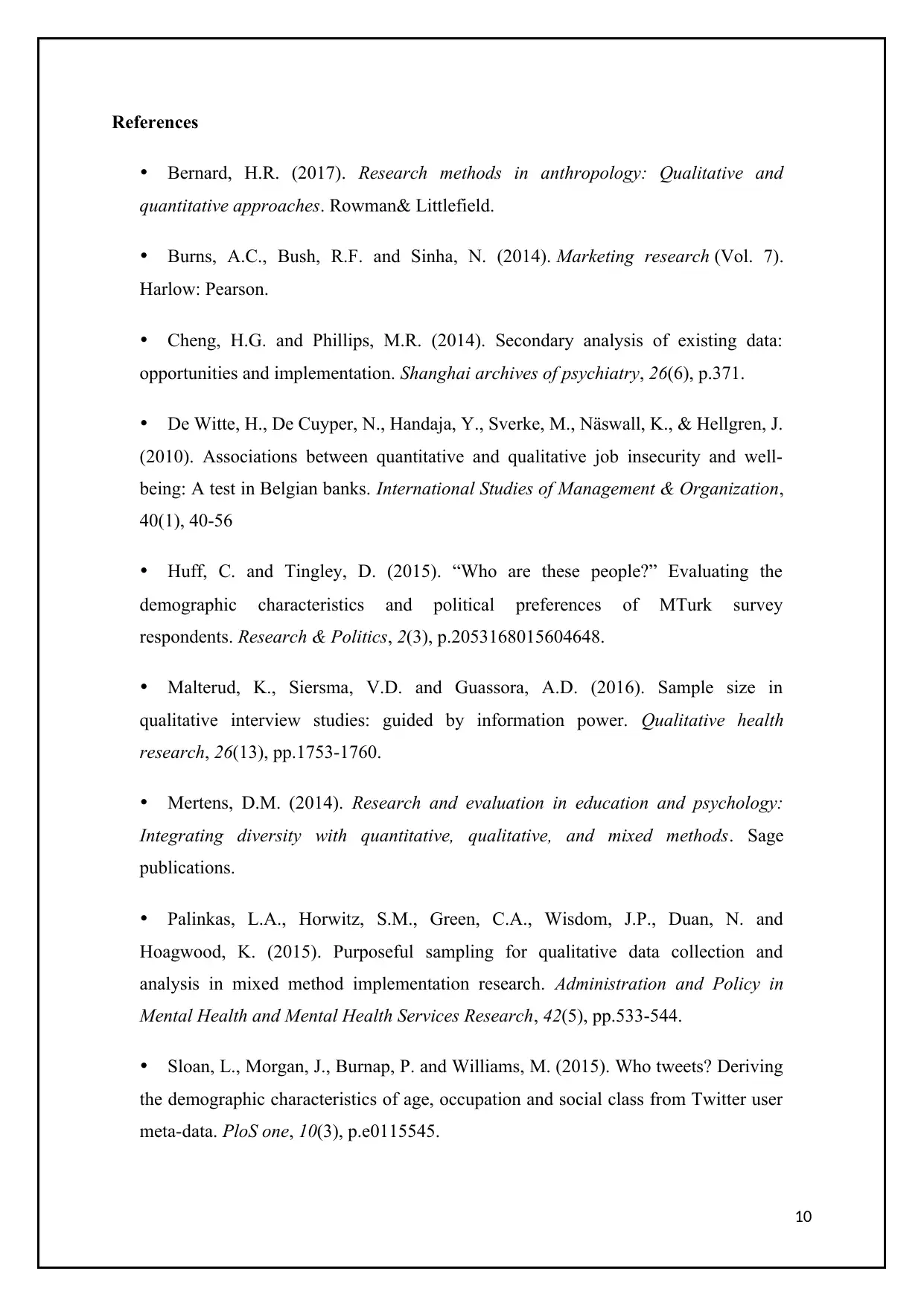
References
Bernard, H.R. (2017). Research methods in anthropology: Qualitative and
quantitative approaches. Rowman& Littlefield.
Burns, A.C., Bush, R.F. and Sinha, N. (2014). Marketing research (Vol. 7).
Harlow: Pearson.
Cheng, H.G. and Phillips, M.R. (2014). Secondary analysis of existing data:
opportunities and implementation. Shanghai archives of psychiatry, 26(6), p.371.
De Witte, H., De Cuyper, N., Handaja, Y., Sverke, M., Näswall, K., & Hellgren, J.
(2010). Associations between quantitative and qualitative job insecurity and well-
being: A test in Belgian banks. International Studies of Management & Organization,
40(1), 40-56
Huff, C. and Tingley, D. (2015). “Who are these people?” Evaluating the
demographic characteristics and political preferences of MTurk survey
respondents. Research & Politics, 2(3), p.2053168015604648.
Malterud, K., Siersma, V.D. and Guassora, A.D. (2016). Sample size in
qualitative interview studies: guided by information power. Qualitative health
research, 26(13), pp.1753-1760.
Mertens, D.M. (2014). Research and evaluation in education and psychology:
Integrating diversity with quantitative, qualitative, and mixed methods. Sage
publications.
Palinkas, L.A., Horwitz, S.M., Green, C.A., Wisdom, J.P., Duan, N. and
Hoagwood, K. (2015). Purposeful sampling for qualitative data collection and
analysis in mixed method implementation research. Administration and Policy in
Mental Health and Mental Health Services Research, 42(5), pp.533-544.
Sloan, L., Morgan, J., Burnap, P. and Williams, M. (2015). Who tweets? Deriving
the demographic characteristics of age, occupation and social class from Twitter user
meta-data. PloS one, 10(3), p.e0115545.
10
Bernard, H.R. (2017). Research methods in anthropology: Qualitative and
quantitative approaches. Rowman& Littlefield.
Burns, A.C., Bush, R.F. and Sinha, N. (2014). Marketing research (Vol. 7).
Harlow: Pearson.
Cheng, H.G. and Phillips, M.R. (2014). Secondary analysis of existing data:
opportunities and implementation. Shanghai archives of psychiatry, 26(6), p.371.
De Witte, H., De Cuyper, N., Handaja, Y., Sverke, M., Näswall, K., & Hellgren, J.
(2010). Associations between quantitative and qualitative job insecurity and well-
being: A test in Belgian banks. International Studies of Management & Organization,
40(1), 40-56
Huff, C. and Tingley, D. (2015). “Who are these people?” Evaluating the
demographic characteristics and political preferences of MTurk survey
respondents. Research & Politics, 2(3), p.2053168015604648.
Malterud, K., Siersma, V.D. and Guassora, A.D. (2016). Sample size in
qualitative interview studies: guided by information power. Qualitative health
research, 26(13), pp.1753-1760.
Mertens, D.M. (2014). Research and evaluation in education and psychology:
Integrating diversity with quantitative, qualitative, and mixed methods. Sage
publications.
Palinkas, L.A., Horwitz, S.M., Green, C.A., Wisdom, J.P., Duan, N. and
Hoagwood, K. (2015). Purposeful sampling for qualitative data collection and
analysis in mixed method implementation research. Administration and Policy in
Mental Health and Mental Health Services Research, 42(5), pp.533-544.
Sloan, L., Morgan, J., Burnap, P. and Williams, M. (2015). Who tweets? Deriving
the demographic characteristics of age, occupation and social class from Twitter user
meta-data. PloS one, 10(3), p.e0115545.
10
1 out of 10
Related Documents
Your All-in-One AI-Powered Toolkit for Academic Success.
+13062052269
info@desklib.com
Available 24*7 on WhatsApp / Email
![[object Object]](/_next/static/media/star-bottom.7253800d.svg)
Unlock your academic potential
Copyright © 2020–2025 A2Z Services. All Rights Reserved. Developed and managed by ZUCOL.





